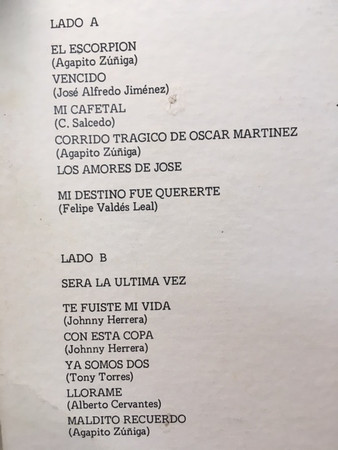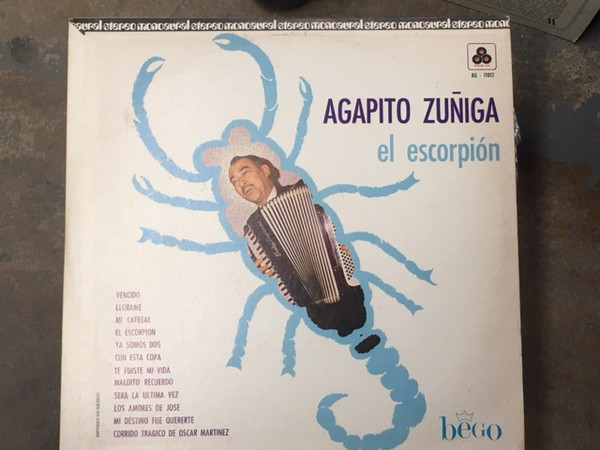Agapito Zuñiga - El Escorpion
Table of Contents
Download
Filename: agapito-zuiga-el-escorpion.rar- MP3 size: 44.4 mb
- FLAC size: 484.8 mb
Tracks
| Track | Duration | Preview |
|---|---|---|
| Con Este Copa | ||
| Llorame | ||
| Sera La Ultima Vez | ||
| El Escorpion | ||
| Los Amores De Jose | ||
| Vencido | ||
| Mi Destino Fue Quererte | ||
| Maldito Recuerdo | ||
| Te Fuiste Mi Vida | ||
| Ya Somos Dos | ||
| Corrido Trajico De Oscar Martinez | ||
| Mi Cafetal |
Video
AGAPITO ZUNIGA EL ESCORPION
Agapito Zuñiga-El Escorpion-1960s
Images






Catalog Numbers
BG-1008Labels
BegoListen online
- lytte på nettet
- online luisteren
- ouvir online
- écouter en ligne
- online anhören
- ascolta in linea
- lyssna på nätet
- escuchar en línea
- kuunnella verkossa
Formats
- Vinyl
- LP
About Agapito Zuñiga
Agapito was born on a ranch known as the "Potreros" in Burgos, Tamaulipas, Mexico on November 19, 1924, to Wenceslao Zuniga Zuniga and Lucia de la Garza Gonzalez. This is his legacy.
He was the seventh son of a family of 13. His musical inclination came at a very early age; conjuring musical ideas was the ideal past time for this young boy. His father took note of his son's interest in music and bought him a harmonicaa harmonica that he played faithfully. This was a major highlight in Agapito's youth because he could now transfer those ideas and make them a reality. By the age of eight, he started playing the accordion. Practice makes perfect and his diligence was impressive. As a result of his diligence, along with the dedicated assistance of two uncles, Marco and Emilio Zuniga, Agapito quickly learned to play the instrument that would one day make his name known throughout the regionhis accordion.
By 1935, the family relocated to Rancho Cypress where they lived for about a year. Given his familys financial economic situation, another move ensued in 1936 to Rancho La Roca located near Sandoval, Tamps. Rancho La Rocas proprietor was Don Dolores Cervantes, father of Catarina Cervantes, who later married Agapito's brother, Julian. At La Roca, Agapito developed an ingenious plan in which to earn additional money for his family. Taking his position with accordion in tow at the Sandoval Railroad Station, he played his accordion and sang while customers waited for the train to arrive. Upon the trains arrival, he would board the train and continued to entertain the trains customers. Everyone seemed happy, but not as happy as the little boy with the accordion!
Indeed, there was something enchanting about La Roca that caused him to feel a deeper yearning to become a musician. His sense of analyzing, comprehending, and performing musical notes simply by watching and listening to other musicians was keen. He easily deciphered complicated notes and reproduced them absent any formal training. His observations, inquisitive mind, and yearning to be the best accordion player made him what he is todaya true pioneer. Rhythmical sounds emanating from the accordions played by other talented musicians not only enlivened Saturday night dances, but also served to usher a transition that would soon take place in his life--a transition from working the fields to becoming one of the greatest accordion players, both in Mexico and the United States.
On May 28, 1954, Agapito arrived in Corpus Christi, Texas where he established his residence. Along with his family, he also brought a colossal repertoire of musical talent. An extraordinary man was about to embark in the United States.
Soon, Agapito reunited with old friends and former co-workers, , and Juans brother, José "Chepe" González. Together, along with Rafael González and Ramon Garcia, they brought a renewed spirit to the group Los Desveladores. Los Desveladores prevailed in attaining many successes during their tenure; however, on August 18, 1958, due to personal reasons, Los Desveladores parted ways indefinitely. Two members of Los Desveladores retained the groups name, while Agapito immediately organized a new musical group and named it "Agapito Zuniga y Su Conjunto." The newly formed group consisting of Agapito, Ramón Garcia, Roberto Torres, Rafael G. González, Juan José Zuniga, and Isidro Govella, traveled and entertained throughout the state of Texas without interruption and much continued success.
With an increase in fame, Agapito was considered as one of the greatest exponents of Texano music. Consequently, this led him and his conjunto to tour across the United States, reaping success, accolades, and the applause of fans. He is also remembered for employing two saxophone musicians in his conjunto (as opposed to one saxophone player used by most, if not all, conjuntos) and the use of the accordion piano (key accordion). Suffice it to say, he was the first musician to incorporate the use of two saxophones and the key accordion in this music genre.
Agapito Zuniga y Su Conjunto clearly demonstrated a strong ambition and the desire to succeed and bring joy to their fans. Artists experience new efforts, new victories, and many disappointments on a daily basis, all of which serve to strengthen their spirit. It is that conscious exertion that produces high energy and leads an artist to work harder to obtain the applause and the consecration of the public. Agapito was no different. He could have jettisoned his career as a musician when failures appeared, but his zeal, spirit, and will were too intense to stop doing what he enjoyed. Music, singing, and playing the accordion were the lifeline to his heart. Manifestation of his success was clearly evident at the box officewhere it counted! He was known by many promoters and the public as a "Magnet at the Box Office."
Agapito and his conjunto were regulars at Club Westerner in Victoria, Texas, a popular dance hall where some of the best conjuntos and orchestras performed. After 10 years of performing at the Club Westerner, Agapito was awarded his first trophy for "Top Public Drawer," which was presented by the late Mr. Juan Manuel Villafranca. More accolades followed. Agapito's second trophy was presented by Discos Bego; the third trophy was presented by Arnulfo Delgado of San Francisco, California; and the fourth trophy was presented in Corpus Christi, Texas by Mr. Domingo Pena in celebration of Agapito and Rafaels silver anniversary for their 25 years of contributions as artists to the music industry.
Agapito Zunigacomposer, successful vocalist, accomplished accordionist, recording artist, and popular performer in the conjunto music genreis a true pioneer. This influential accordionist recorded numerous songs with recording companies Peerless, Ideal, Bego, El Toro, Falcón, Freddie Records, Frontera, and Hacienda. In the late 1960s, Agapito started his own recording company and produced many recordings under his label of Escorpión Records (Discos Escorpión) for his conjunto, as well as other start-up conjuntos who needed to get their foot in the door.
Since his arrival in Corpus Christi, he livened up weekly dances held in the surrounding agricultural communities, whose Mexican population increased considerably during cotton harvesting season. He also performed in theaters, alternating performances with top-notched artists like Lydia Mendoza, Chelo Silva, Isidro Lopez, Andrés Huesca, Valerio Longoria, Narciso Martínez, Juan López, and many more. It was around that time period that Agapito became known as "El Escorpión de Texas."
Agapito's name was now a household word; he reached new heights, much success, and popularity. Consequently, he and his group were invited to appear live on several occasions on the Domingo Pena Show, a popular show aired weekly on Sundays.
With success, came other opportunities. On February 10, 1960, Agapito was offered a contract with Radio Station KCCT, which he delightfully accepted. The program was called "La Hora de Agapito Zuniga". . . better known as "Con Alma Chiquitita" (his trademark). Shortly thereafter, KCCT increased his broadcast to air on a daily basis due to its popularity. The program aired successfully for many years.
Name Vars
- A. Zuniga
- Agapito
- Agapito Zuniga
- Agapito Zuñiga y los Desveladores
- Agapito Zúñiga
- Zuñiga
Comments
Me pueden dejar este disco. Completo
Agapito Zuñiga, paisano de Burgos, Tamaulipas, México; joven emigró hacia la frontera y de ahí al Valle de Texas
Please shout out if you are from Beeville, Texas.
If you have "La guera Y La Prieta" please upload it. Or someone reading this. Thanks for all this good music
He was one of my mother's favorites and we always went when he played at one of the dance halls in Beeville, Texas. At times, he would allow me to sing one of his songs while his "Conjunto" played. He was, as I remember, a great gentleman. There is no voice to compare. Thank you for posting. My mother died six months ago and these are some of my childhood memories. Thanks again!
I remember when I first heard this song back in the 60's, I was headed to school my had the radio on and heard this song, from then on I waited to get my money for my chores I did too get money, I talked my father to take me to the record shop on Zamora st.and bought the 45s that was the good old days!
RIP 01/20/2015....Passes in South Texas...A real Texas musical legend...
Puro Burgos, Tamaulipas pa toda la raza! Saludos!
This is some old school. Oy!
If you or anyone else reading this can find "La Guera Y La Prieta" a mano a mano song between Agapito and El Pato please put it on youtube. Thank you.
Hey Patty! Wow! This is great! This takes me to my old native Brownsville, Texas polkas alright at the Brownsville Centro Civico back in the late 1950s and early 1960s. By any chance, do you have any Isidro Lopez and Freddy Gomez musica? These were the top singers in the late 50s and early 60s too. Keep it up Patty! - E.F. Mohammed Martinez - East L.A. Since 1972, But I'm Still A Tejano del Valle del Rio Grande de Corazon! Ajuaaaaaaa! (Ahem!)
